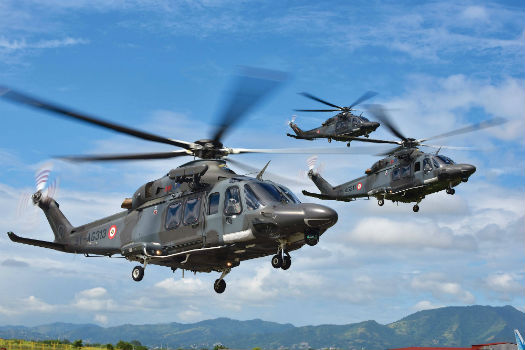
The Trinidad and Tobago Air Guard’s fleet of AW139s recently surpassed 5,000 flight hours. The unit continues to expand its operational capabilities.
On the morning of Dec. 15, 2014, Trinidad and Tobago Air Guard pilots Christen Garnes and Kevin Maharaj departed the Air Guard’s base at Piarco International Airport in an AgustaWestland AW139 helicopter. The weather was fine — warm, humid, and partly cloudy, as it often is in this twin island nation in the southeast corner of the Caribbean Sea. The flight was a routine patrol mission along the north coast of Trinidad, and it proved to be relatively uneventful.
If the flight itself was uneventful, the occasion was nothing short of historic. The mission marked the first time that an all-local crew had taken command of one of the Air Guard’s four AW139s — a key milestone for this fledgling air unit, which before 2011 had no helicopters at all.
When Garnes and Maharaj returned to base, the newly promoted command officers were heralded at a ceremony attended by, among others, Permanent Secretary of National Security Carl Francis. “In four years, we’ve brought something from nothing,” Francis told the pilots and their assembled peers. “Continue achieving what you’re achieving.”
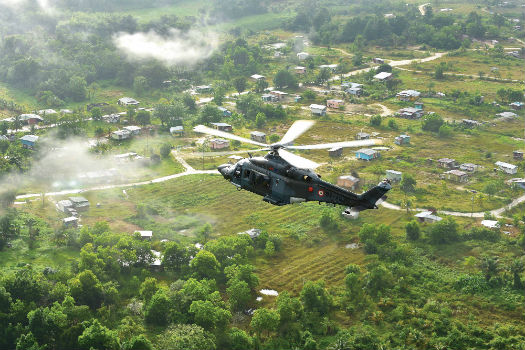
AgustaWestland is providing extensive training to the Trinidad and Tobago Air Guard under a five-year contract, with the ultimate goal of transitioning the Air Guard to self-sufficiency.
When “something” is a military helicopter capability, four years is a remarkably short period of time in which to build it from scratch. Yet Trinidad and Tobago has attempted to do exactly that, standing up the only Air Guard of its kind in this section of the Caribbean. For the men and women charged with making it work, it has been an incredible journey — a voyage of personal and patriotic accomplishment of which they are justly proud. In December, Vertical visited the Ulric Cross Air Station in Trinidad to witness Garnes and Maharaj’s historic flight, and to learn more about the challenges of creating an Air Guard from the ground up.
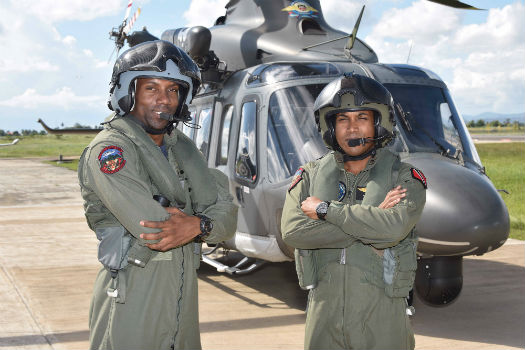
From Zero to 60
The Trinidad and Tobago Air Guard is the direct descendant of the country’s Coast Guard Air Wing, which was established in 1966 with a single Cessna Skymaster to perform surveillance and search-and-rescue (SAR) missions. The Air Wing operated a variety of fixed-wing platforms over the years — including Piper Navajos and Fairchild C-26 Metroliners — but it only dabbled in helicopters, briefly operating four Aérospatiale Gazelles in the 1970s before they were transferred to the Air Division of the Ministry of National Security (which became National Helicopter Services Ltd. in 1989).

In the 2000s, ambitions of expanding Trinidad and Tobago’s influence in the Caribbean led to the government signing a contract for three offshore patrol vessels, which were intended to operate with helicopter support. In order to serve the broader mandate of the country’s Defense Force, the Coast Guard Air Wing was transformed into the Trinidad and Tobago Air Guard in 2005. In 2009, the government signed a US$348 million contract with AgustaWestland for four AW139 helicopters, plus a five-year training and logistical support package.

The contract for the offshore patrol vessels was canceled in 2010. However, the contract for the helicopters was not, and the Air Guard took delivery of its first two AW139s in 2011. Consequently, the acquisition was not without its critics, and the program has countered questions about its expense and aircraft availability.
It’s understandable that a small nation like Trinidad and Tobago (which has a population of around 1.2 million) would want to see immediate returns on such a sizable investment. That said, it’s difficult to overstate the challenges involved in creating a military helicopter capability where none existed before, particularly at the level at which Trinidad and Tobago is tackling it.
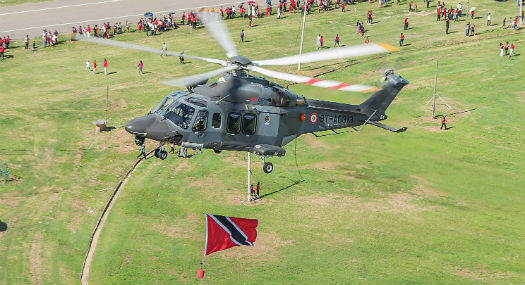
Ryan Mason Photo
When the Air Guard ordered its AW139s, only a small number of personnel were involved in operating and maintaining its fixed-wing aircraft. Most of its recruits — including pilots like Garnes and Maharaj — were new not only to helicopters, but to aviation in general. Now, “they’re flying one of the most capable helicopters in the world, and they’re flying it in complex missions,” said AgustaWestland’s director of flying operations in Trinidad and Tobago, Steve Bradburn. “They’ve risen to the challenge.”
AgustaWestland is responsible for the success of the training and logistical support contract, which runs through the end of 2015, but it has brought in partners to help with the effort. Among them is Helidecks, a U.K.-based training service. Bradburn, a former Royal Navy pilot, is part of the AgustaWestland team of 11 flight operations personnel in Trinidad and Tobago. The AgustaWestland-contracted pilots and rear crew fly alongside Air Guard personnel, providing them with training, supervision, and mentoring. They also oversee the Air Guard pilots’ continuing ground education, with the goal of developing them into command officers and, ultimately, qualifying them for command of SAR and other complex missions.
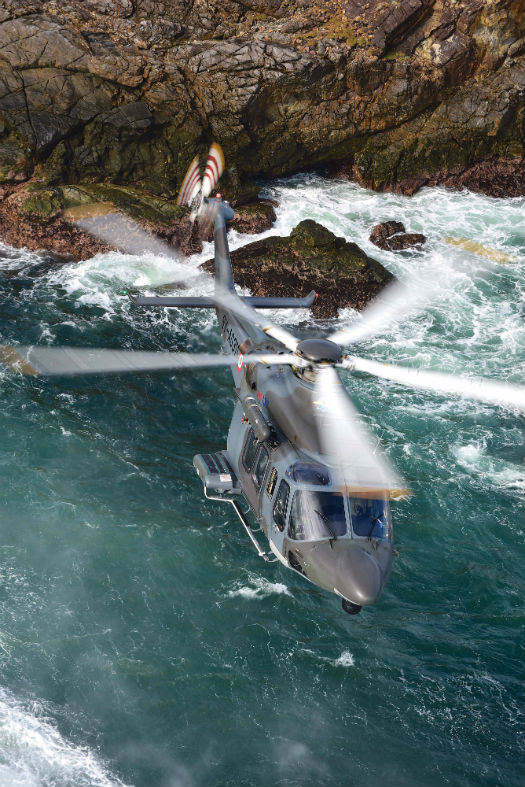
Maritime patrol is one of the Air Guard’s primary missions.
AgustaWestland’s other principal subcontractor in Trinidad and Tobago is Cobham, which also supplies some training personnel, and which holds the Air Guard’s Air Operator Certificate (AOC), having recently taken it over from Bristow Caribbean Ltd. Although the Air Guard is a military unit, Trinidad and Tobago has chosen to operate its helicopters as civilian-registered aircraft, in accordance with the regulations of the Trinidad and Tobago Civil Aviation Authority (TTCAA). Doing so has put significant restrictions on what the Air Guard can do — like most civil aviation authorities, Trinidad and Tobago’s simply isn’t set up to permit the full spectrum of military missions. However, if a civilian AOC has at times been a handicap for the Air Guard, it has also provided it with a clear structure and standards, enhancing the new unit’s credibility. And credibility is important for the Air Guard: according to Group Commander Darryl Daniel, the unit’s vision for the future is nothing less than “to be the premier military aviation organization in the region.” He expressed confidence that the Air Guard is on the right track, telling Vertical, “I think what we have achieved in four years is quite remarkable.”
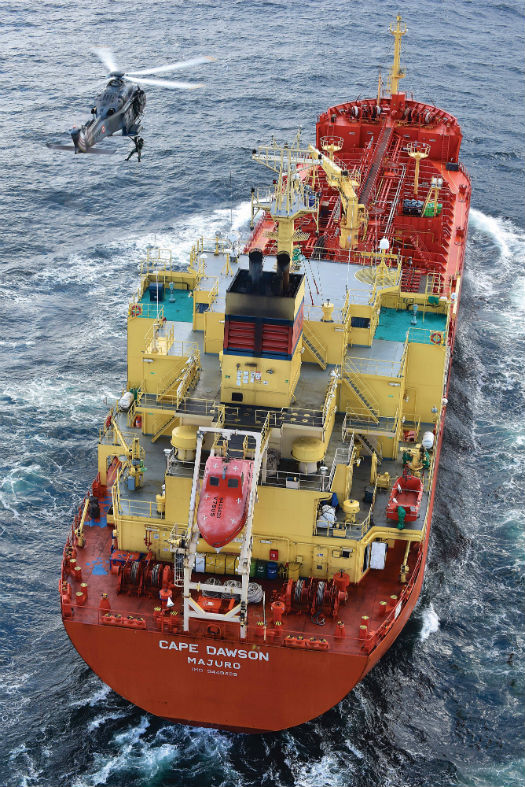
Air Guard personnel practice deck landings on the Cape Dawson, a passing tanker ship. Such exercises demand utmost concentration and cooperation from every member of the crew.
Growing Capacity
The morning after Garnes and Maharaj’s first flight as command officers, two AW139s took off from the Air Guard’s base on a SAR training mission, with Vertical along for the ride. With nine more Air Guard pilots still working toward command officer status — and all of the unit’s pilots and rear crew needing additional SAR and special mission experience — training remains one of the Air Guard’s top priorities. At present, each AW139 is flying an average of around 60 hours per month, with training accounting for approximately half of the total flight time (patrol is the next most common mission, with other operations including SAR, medevac, VIP transport, disaster relief, and firefighting). On this sortie, each helicopter had a contract instructor pilot in the cockpit and a contract crewmember in back, with an Air Guard pilot and crewmember acting under their supervision.

Search-and-rescue operations are among the most demanding of the Air Guard’s missions. Consequently, the Air Guard trains for them constantly.
Although there were patchy low clouds and mist in the mountains near Piarco International Airport, the ceilings lifted off the northeast point of Trinidad, where the helicopters radioed and then rendezvoused with the Cape Dawson, a tanker ship that happened to be passing through the area. Not every ship captain is happy to let his or her vessel be used for SAR practice, but many captains are, recognizing that they may someday have an acute need for the Air Guard’s services. The Cape Dawson’s captain was one of the accommodating ones. Each helicopter took turns approaching the ship near its bridge, winching a crewmember down to the deck, moving away, then returning to hoist the crewmember back into the cabin.
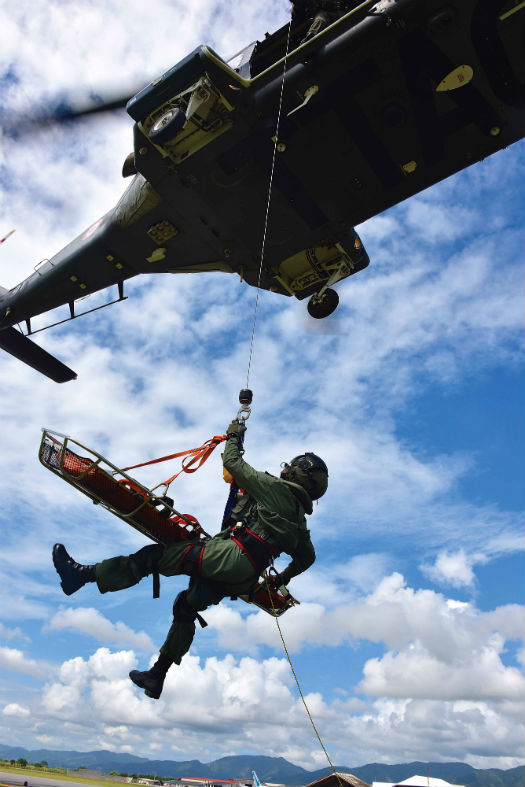
In the back of one of the AW139s was Mick Cook, a former Royal Navy and Irish Coast Guard aircrewman who, over a four-decade-long career, has taken part in military and SAR operations all over the world. He was advising Hani Vieira, the Air Guard crewmember who would be going down on the hoist this time. As the AW139 approached the tanker, Cook led the crew through a quick but thorough hazards briefing, then verbally guided the pilots into position beside the ship. Vieira double-checked his rigging, then climbed out of the open cabin door, to be winched down before the onlookers aboard the Cape Dawson.
The exercise went fairly smoothly, although if it hadn’t, Cook probably would have maintained his same demeanor of calm alertness. “You can’t get frustrated in the aircraft,” Cook said later, explaining that tension during an operation spreads quickly through the crew. Above all, he said, the key to success is having confidence in everyone on board the helicopter: “You have to trust each other in any SAR unit.”

The Air Guard’s AW139s are equipped with a variety of special mission equipment, including Goodrich dual rescue hoists, EuroAvionics EuroNav moving map displays, Telephonics radar, FLIR Star SAFIRE III electro-optic/infrared camera systems, and Spectrolab SX-16 Nightsun searchlights. Ryan Mason Photo
In general, the relationship between Air Guard personnel and their hired instructors is one of trust and mutual respect. “They have been very gracious about their position,” said pilot and Squadron Leader Kemba Hannays, praising the contractors for taking into consideration the Air Guard’s specific goals and needs, while simultaneously holding them to high international standards. “We’ve learned a lot from them,” she said.
For their part, the instructors are fully appreciative of the learning curve faced by the Air Guard’s flight crews — one that pilot and Squadron Leader Marlon Dowrich described as “straight up; a straight line.” Air Guard pilots were sent for their initial flight training to Bristow Academy in Titusville, Fla., where they trained in the piston-engine Sikorsky (formerly Schweizer) S-300, with some additional instruction in military operations through Bristow’s military training arm. Then, they went through transition training with AgustaWestland in the AW139, a helicopter that is orders of magnitude larger and more complex than the one in which they learned to fly. “It’s like jumping from a Mini into a Ferrari,” said Helidecks chief flying instructor Ian Walsh. “It’s a difficult project.”
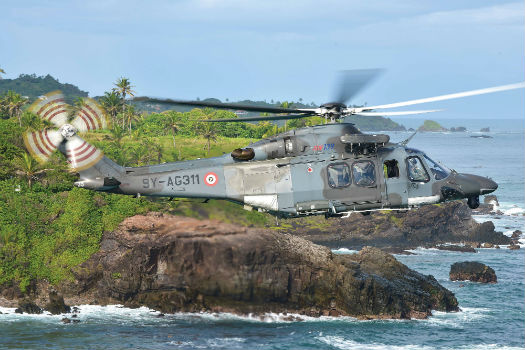
The Air Guard’s helicopters have civilian registrations, subjecting them to the regulations of the Trinidad and Tobago Civil Aviation Authority. While this has presented some challenges for the Air Guard, it has also provided the fledgling unit with a clear operational framework and standards.
Mike Hotze, vice president of customer support and training at AgustaWestland Philadelphia Corporation, said the program showed the manufacturer’s customer support, training, and logistics abilities. “Bringing these core competencies, as well as our training and program management expertise, closer to, and in this case, in conjunction with, the customer, ensures that we are further invested in the success of customer operations around the world.”
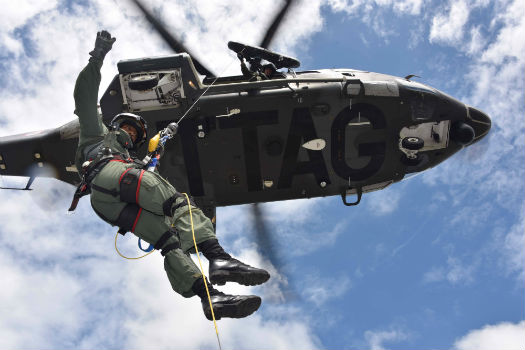
The Air Guard’s growing list of accomplishments are a source of pride for its personnel — and for the country at large.
Building a legacy
Although most of the Air Guard’s pilots were brand-new to aviation when they started their helicopter training, the unit did benefit from some experienced personnel on the maintenance side, through engineers who had started their aviation careers with the Coast Guard Air Wing. Of course, they, too, faced their challenges transitioning to the AW139 from airplanes. Warrant Officer Desi Geoffroy, a maintenance engineer who began his military career in 1998, noted that “rotorcraft in general are a lot different from fixed-wing,” and that the AW139 in particular is “a very modern helicopter with a lot of modern systems.” Moreover, the Air Guard’s engineers, like everyone else in the unit, were under intense pressure to perform. “It was a challenge and a lot of studying and a lot of training,” recalled Geoffroy. “A lot of people were watching us. . . . That would keep you going on the days you wanted to give up.”

Geoffroy and his colleagues prevailed. The ceremony that recognized newly promoted Command Officers Christen Garnes and Kevin Maharaj also honored five Air Guard maintenance engineers who are now fully licensed by the Trinidad and Tobago Civil Aviation Authority: Geoffroy, Sergeant Jeremy Wilson, and Warrant Officers Brent Nora, Vinod Sawh, and Vinod Rambaran. Beyond the symbolic achievement of licensure, having five qualified engineers in the Air Guard helps move the unit closer to self-sufficiency. But it still has a long way to go — of the other personnel in the maintenance department, at least three-quarters of them “are pretty green,” said Sawh.
As new as the Air Guard is, capacity building will remain its greatest challenge for some time to come. There are currently 476 personnel in the Air Guard, and the Defense Force would like to grow that number, according to Group Commander Darryl Daniel. Daniel said that recruiting people for the Air Guard isn’t a problem, because of the excitement surrounding the unit and what it does. He acknowledged, however, that it will take time to populate the senior leadership ranks with experienced aviation personnel. (In the future, the Air Guard may also have to worry about losing some of those experienced personnel to commercial operators, which presently pay much more than the Air Guard.)
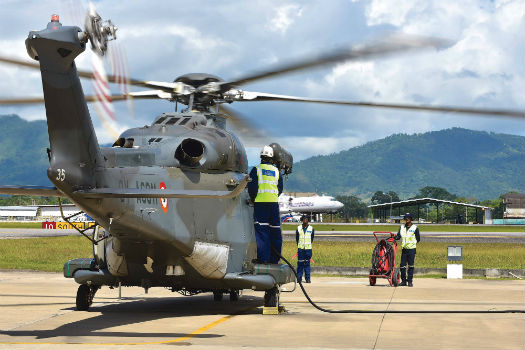
For the time being, however, the Air Guard’s strikingly young work force has given it a sense of energy and optimism that’s missing from many established air units. That’s accentuated by the fact that, for most Air Guard personnel, their duties are a source of intense personal and national pride, particularly as the unit begins to make more of an impact with operational missions. For example, in late December, the Air Guard gained widespread recognition for rescuing a lost American tourist, who credited the unit with saving his life.
“If I’m off duty and I see the aircraft go by, it makes me warm inside that I’m part of that whole process,” Sawh told Vertical. “That is my reward. I can see that I’m responsible for that aircraft being there.”





